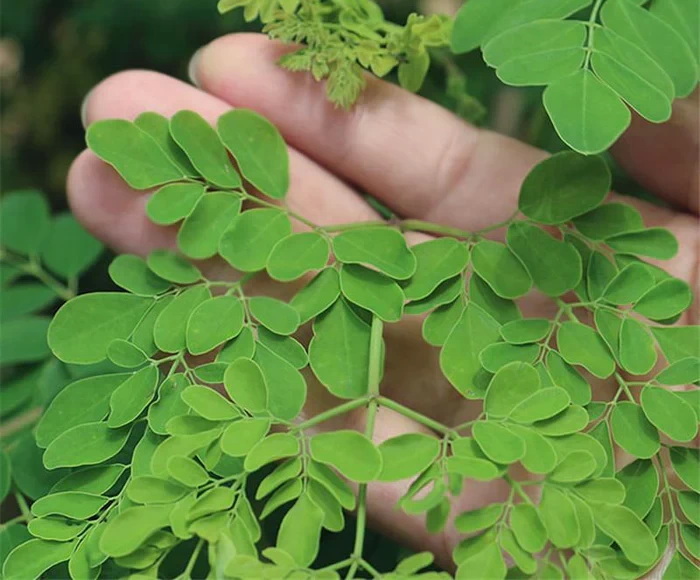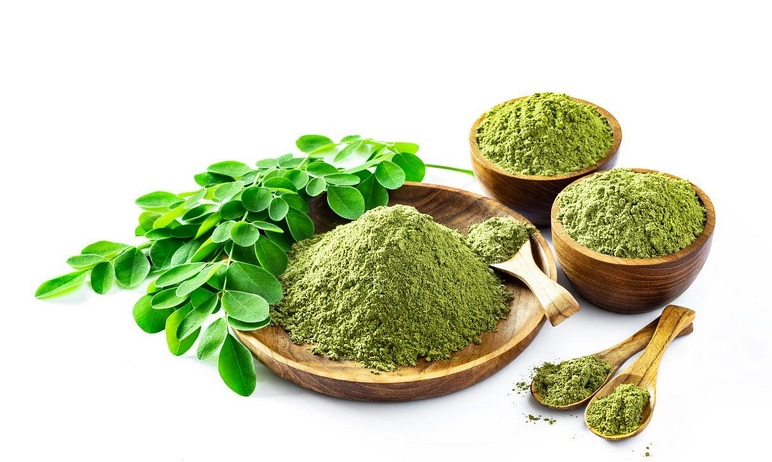Content Menu
● Introduction to China Moringa Leaf Extract
● Harvesting and Preparing Moringa Leaves
>> Fresh Leaf Collection
>> Cleaning and Sorting
>> Drying Techniques
● Grinding and Pulverization
● Extraction Process of China Moringa Leaf Extract
>> Subcritical Fluid Extraction Technology
>> Solvent Recovery and Concentration
>> Purification of Flavonoids and Saponins
>> Enzymatic Treatment (Optional)
● Quality Control and Testing
● Packaging and Storage
● Applications of China Moringa Leaf Extract
● Cultivation and Sustainable Practices
● Health Benefits and Nutritional Value
● Market Demand and Global Reach
● Research and Development
● Conclusion
● FAQ
>> 1. What solvents are used in the extraction of China Moringa Leaf Extract?
>> 2. How does subcritical fluid extraction benefit Moringa leaf extract production?
>> 3. What quality standards does China Moringa Leaf Extract meet?
>> 4. Can Moringa leaf extract be made at home?
>> 5. What are the main bioactive compounds in China Moringa Leaf Extract?
Moringa oleifera, often called the “miracle tree,” has gained global attention for its rich nutritional profile and health benefits. China Moringa Leaf Extract, derived from the leaves of the Moringa tree grown in China, is highly valued for its purity, potency, and diverse applications in health supplements, cosmetics, and food industries. This comprehensive article explores the detailed process of how China Moringa Leaf Extract is made, from leaf harvesting to extraction, purification, and packaging, highlighting the advanced technologies and quality control measures involved.

Introduction to China Moringa Leaf Extract
China Moringa Leaf Extract is a concentrated powder or liquid derived from the leaves of the Moringa oleifera tree cultivated in China. The extract is rich in bioactive compounds such as flavonoids, saponins, vitamins, antioxidants, and essential minerals. These compounds contribute to its antioxidant, anti-inflammatory, immune-boosting, and nutritional benefits, making it a sought-after ingredient in health and wellness products.
Harvesting and Preparing Moringa Leaves
Fresh Leaf Collection
The process begins with harvesting fresh Moringa leaves, typically from mature trees grown in regions like Yunnan, Guangxi, and Guangdong provinces. Leaves are handpicked carefully to avoid damage, ensuring the highest quality raw material.
Cleaning and Sorting
Once harvested, the leaves undergo thorough cleaning to remove dirt, dust, and impurities. This step often involves washing the leaves with clean water and sometimes soaking them in a mild vinegar solution to reduce microbial contamination.
Drying Techniques
Drying is a critical step to preserve the leaves' nutritional content and prevent spoilage. In China, advanced drying methods such as infrared drying or accelerated freeze-drying are employed to reduce moisture content to below 10%. These methods help retain the bright green color and bioactive compounds of the leaves, avoiding the browning that occurs with slower drying methods.
Grinding and Pulverization
After drying, the leaves are pulverized into a fine powder using industrial grinders. The powder is typically sieved through fine meshes (200 to 700 mesh) to achieve uniform particle size, which is essential for efficient extraction.
Extraction Process of China Moringa Leaf Extract
Subcritical Fluid Extraction Technology
China has pioneered the use of subcritical fluid extraction for Moringa leaf extract production. This method involves placing the powdered leaves into a sealed extraction kettle under vacuum conditions (0.06 to 0.1 MPa). An organic solvent such as methanol or ethanol is added at a solid-to-liquid ratio ranging from 1:5 to 1:20 (g/ml).
The extraction kettle is heated to subcritical temperatures (80°C to 200°C) and pressurized (up to 4 MPa), allowing the solvent to penetrate the plant material efficiently and dissolve the bioactive compounds. The extraction is repeated multiple times (2 to 3 cycles), each lasting from 15 minutes to several hours depending on the protocol.
Solvent Recovery and Concentration
The extract solution is then transferred to a solvent recovery still where the solvent is removed under reduced pressure (vacuum). This step concentrates the extract into a black-green viscous mass known as the crude extract.
Purification of Flavonoids and Saponins
The crude extract contains various compounds, including flavonoids and saponins, which are the primary bioactive ingredients.
- Flavonoid Extraction: The crude extract is subjected to sequential solvent extractions using ethyl acetate and n-butanol. The combined extracts are concentrated and dried to obtain a brown-yellow flavonoid-rich extract. This extract is further purified using silica gel column chromatography with gradient elution based on polarity. The fractions with high flavonoid content (above 97%) are collected and recrystallized with methanol or ethanol to achieve purity levels exceeding 98%.
- Saponin Extraction: The remaining phase after flavonoid extraction is treated with solvents such as acetone and diethyl ether, followed by centrifugation and concentration. The saponin-rich extract is purified similarly using macroporous resin columns and gradient elution. The saponins are crystallized from aqueous solutions and recrystallized multiple times to reach purities above 98%.
Enzymatic Treatment (Optional)
Some manufacturers incorporate an enzymolysis step before extraction, using a compound cellulase enzyme mixture to break down cell walls and improve extraction yield. This process is carried out at controlled temperature and pH for several hours.
Quality Control and Testing
China Moringa Leaf Extract undergoes rigorous quality control to ensure safety, potency, and purity. Parameters tested include:
- Moisture content (kept below 5%)
- Heavy metals and microbial contamination (must meet strict limits)
- Assay of active compounds using HPLC or UV spectrometry
- Physical properties such as color, taste, and particle size
Certified manufacturers often comply with ISO, HACCP, Halal, and Kosher standards to meet international market requirements.
Packaging and Storage
The final Moringa leaf extract powder is packaged in airtight, moisture-proof containers to preserve its quality and extend shelf life. Bulk packaging is available in various sizes from 50 grams to 50 kilograms, with options for private labeling.
Applications of China Moringa Leaf Extract
- Nutritional Supplements: Capsules, tablets, and powders for immune support and overall wellness.
- Food and Beverage: Added to smoothies, teas, and health drinks for nutritional enhancement.
- Cosmetics: Incorporated into skin care products for antioxidant and anti-aging effects.
- Agriculture: Used as a natural growth enhancer and fertilizer extract.

Cultivation and Sustainable Practices
China's cultivation of Moringa trees emphasizes sustainable agricultural practices to ensure environmental protection and product quality. Farmers use organic fertilizers and avoid harmful pesticides, promoting soil health and biodiversity. The trees are grown in regions with optimal climate conditions, ensuring robust growth and high nutrient content in the leaves.
Sustainability efforts also include water conservation techniques and integrated pest management to minimize environmental impact. These practices contribute to the consistent quality of China Moringa Leaf Extract and support the long-term viability of Moringa cultivation in China.
Health Benefits and Nutritional Value
China Moringa Leaf Extract is celebrated for its comprehensive health benefits. It contains essential amino acids, vitamins A, C, and E, calcium, potassium, and iron. These nutrients support immune function, improve skin health, reduce inflammation, and provide antioxidant protection against free radicals.
Regular consumption of Moringa extract is linked to enhanced energy levels, better digestion, and cardiovascular health. The flavonoids and saponins in the extract have been studied for their potential to lower blood sugar levels, reduce cholesterol, and support liver function. Additionally, its anti-inflammatory properties may aid in managing arthritis and other chronic inflammatory conditions.
Market Demand and Global Reach
The demand for China Moringa Leaf Extract has surged globally due to increasing awareness of natural health products. It is exported to various countries and incorporated into dietary supplements, functional foods, and cosmetic formulations.
Manufacturers continuously innovate extraction and formulation techniques to meet diverse consumer needs and regulatory standards worldwide. The growing trend toward plant-based and organic products further fuels the market expansion of China Moringa Leaf Extract.
Research and Development
Ongoing research in China focuses on optimizing extraction methods to maximize yield and bioactivity. Studies explore the synergistic effects of Moringa compounds and their potential in managing chronic diseases such as diabetes, hypertension, and arthritis.
Innovations include enzymatic pretreatment to enhance extraction efficiency and the development of standardized extracts with consistent bioactive content. Scientific validation of health claims strengthens the credibility and marketability of China Moringa Leaf Extract, supporting its role in integrative health approaches.
Conclusion
China Moringa Leaf Extract is produced through a sophisticated process that combines traditional harvesting with modern extraction technologies such as subcritical fluid extraction and chromatographic purification. This ensures a high-quality, potent product rich in flavonoids and saponins, with broad applications in health, nutrition, cosmetics, and agriculture. The meticulous drying, extraction, and purification steps preserve the bioactive compounds, making China Moringa Leaf Extract a trusted ingredient worldwide.
Sustainable cultivation practices and ongoing research further enhance the product's quality and efficacy, meeting the growing global demand for natural health solutions. As awareness of Moringa's benefits expands, China Moringa Leaf Extract is poised to remain a key player in the global natural products market.

FAQ
1. What solvents are used in the extraction of China Moringa Leaf Extract?
Organic solvents such as methanol, ethanol, ethyl acetate, n-butanol, acetone, and diethyl ether are commonly used in various stages of extraction and purification to isolate flavonoids and saponins from Moringa leaves.
2. How does subcritical fluid extraction benefit Moringa leaf extract production?
Subcritical fluid extraction operates under controlled temperature and pressure below the critical point of solvents, allowing efficient extraction with less solvent use, shorter extraction time, and higher purity of bioactive compounds.
3. What quality standards does China Moringa Leaf Extract meet?
Leading manufacturers ensure compliance with ISO9001, HACCP, Halal, Kosher, and other international certifications, testing for purity, microbial safety, heavy metals, and active compound content.
4. Can Moringa leaf extract be made at home?
Yes, simple aqueous Moringa leaf extracts can be made by crushing fresh leaves and soaking them in water, followed by straining. However, commercial extracts from China use advanced solvent extraction and purification for higher potency.
5. What are the main bioactive compounds in China Moringa Leaf Extract?
The extract is rich in flavonoids (e.g., quercetin derivatives) and saponins, along with vitamins, minerals, and antioxidants, which contribute to its health benefits.

 English
English 




























